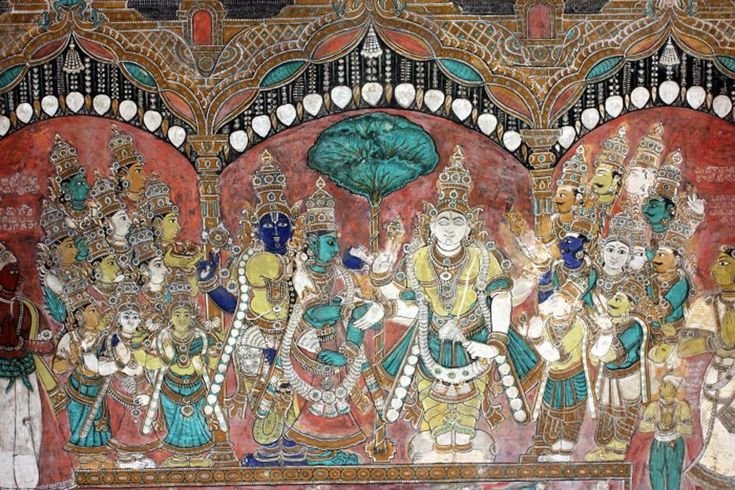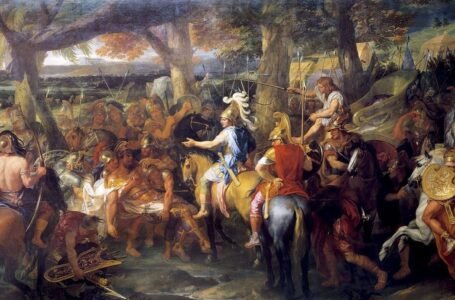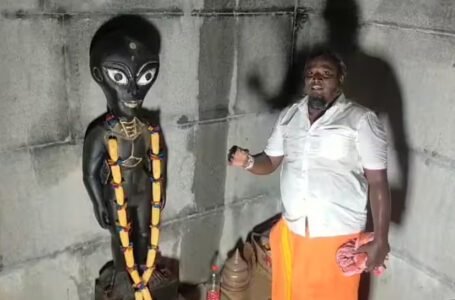Kalamkari Temple Paintings of Tamil Nadu: A Sacred Tradition in Decline

Kalamkari, with its intricate designs and rich history, is celebrated for its artistic beauty and cultural significance. But beyond the well-known commercial versions of this textile art lies a more sacred and lesser-known tradition—the Kalamkari temple paintings of Tamil Nadu. Unlike their market-driven counterparts, these paintings are created as devotional offerings in temples, depicting divine stories and cosmic themes. They hold deep spiritual meaning, yet this sacred art form is fading fast, threatened by modernization, dwindling patronage, and the rise of mass-produced alternatives.
This article delves into the rich history, artistic techniques, themes, and gradual decline of Tamil Nadu’s temple Kalamkari paintings. Once an integral part of temple rituals and storytelling, these sacred artworks are now fading into obscurity. With their deep religious significance, the urgency to revive this tradition has never been greater.
Kalamkari temple paintings have their roots in the ancient temple traditions of South India, where textile-based religious art was more than just decoration—it was a vital part of storytelling, worship, and rituals. Unlike the more commercialized forms of Kalamkari that emerged later, temple Kalamkari was a sacred offering, meticulously created by skilled artisans known as Kalamkaris or Chitrakars.
In Tamil Nadu, with its deep-rooted temple culture, this art form flourished, particularly in places like Kanchipuram, Chidambaram, Madurai, and Srikalahasti (which, though now in Andhra Pradesh, has historical ties to Tamil Nadu). Temples and devotees commissioned these paintings not only for their spiritual significance but also for their role in grand festivals and religious processions.
Unlike Machi Kalamkari, which is mass-produced using block printing for commercial purposes, temple Kalamkari remains a purely hand-painted tradition, deeply rooted in religious customs. It follows strict guidelines, making it more than just an art form—it’s a sacred practice.
One of the key aspects of temple Kalamkari is its use of natural dyes. Artisans carefully extract colors from plant-based sources like pomegranate rind, myrobalan, indigo, and madder root. These aren’t just chosen for their beauty; each color carries deep symbolic meaning in Hindu cosmology.
The themes and imagery in these paintings revolve around Hindu mythology and temple traditions. Scenes from the Ramayana and Mahabharata, temple legends, and grand divine processions are commonly depicted, with gods like Vishnu, Shiva, Devi, and Ganesha brought to life in intricate detail.
Creating a temple Kalamkari piece is a ritual in itself. Artisans undergo purifications, fasting, and prayers before and during the process, treating their work as an act of devotion rather than just craftsmanship.
These paintings serve important roles in temples—they adorn sanctums, drape over deity idols during rituals, and decorate temple chariots during processions. Some even act as stunning backdrops (prabhavali) in temple shrines, adding to the spiritual ambiance of these sacred spaces.
Despite its deep religious significance, temple Kalamkari is slowly fading away. Several factors have contributed to its decline:
Lack of Patronage: In the past, temples and royal courts actively commissioned and supported this art form. But today, both government funding and temple sponsorships have significantly decreased, leaving artisans with little financial support.
Mass-Produced Alternatives: With the rise of printed fabrics and synthetic materials, the demand for authentic, hand-painted temple Kalamkari has dwindled. Many temples now opt for cheaper, factory-made alternatives, sidelining this centuries-old tradition.
Declining Number of Artisans: Creating temple Kalamkari requires years of training and strict adherence to religious rituals. Fewer artisans are willing to dedicate themselves to this demanding craft, and many traditional Kalamkari families have either shifted to commercial work or abandoned the profession altogether.
Loss of Religious Context: Many temples that once used these paintings for rituals and festivals have stopped the practice or replaced them with modern materials, further distancing Kalamkari from its sacred origins.
Environmental and Economic Challenges: One of the biggest hurdles for temple Kalamkari artisans is the use of natural dyes. Sourcing and processing plant-based dyes is a time-consuming and expensive process, making it difficult to sustain. On top of that, with little financial support or incentives, many artists find it impossible to make a living from this craft, forcing them to look for other means of income.
Reviving Tamil Nadu’s temple Kalamkari tradition will require a combined effort from both the government and local communities. Here are some key steps that could help bring this sacred art back to life:
- Temple Sponsorships: Temples can play a major role by commissioning and restoring traditional Kalamkari works as part of their renovation projects. Bringing these paintings back into temple spaces would reinforce their religious and cultural significance.
- Government Support: Financial aid, scholarships, and heritage status for temple Kalamkari artisans could provide much-needed encouragement and recognition. Without proper funding, many skilled artists are forced to abandon the craft.
- Education and Awareness: Art schools and cultural institutions should introduce temple Kalamkari into their curricula. Organizing exhibitions and workshops can also help educate the public about its value and keep the tradition alive for future generations.
- Sustainable Market Strategies: While staying true to its sacred roots, temple Kalamkari could be adapted for limited-edition textiles, museum collections, or curated displays. This would create a sustainable source of income for artisans without compromising the spiritual essence of the art.
Community and NGO Involvement: Devotees, temple trusts, and non-profit organizations can help by funding temple-based workshops and supporting artisans directly. When more people take an interest, demand for these sacred paintings will naturally grow.
Temple Kalamkari, once a vibrant and essential part of Tamil Nadu’s temple culture, is now at risk of being lost to time. Unlike the mass-produced versions of Kalamkari that we see today, this sacred art form was never meant for commerce—it was a devotional offering, created with deep reverence and spiritual purpose. The decline of this tradition isn’t just the fading of an art style; it’s the loss of a powerful storytelling medium that has been woven into the rituals and celebrations of temples for centuries.
The reasons behind this decline are multifaceted: reduced patronage, the advent of mass-produced alternatives, a shrinking pool of skilled artisans, and the shift in many temples away from traditional practices. On top of this, environmental and economic challenges make it even harder for artisans to continue this work. The intricate process of using natural dyes and traditional methods is not only labor-intensive but also increasingly unsustainable without proper support. Without action, temple Kalamkari could soon be nothing more than a forgotten tradition, preserved only in museum collections.
Yet, all is not lost. Revival is possible if we act now. Temples can be encouraged to sponsor and restore traditional Kalamkari works, while government grants and educational programs can provide the financial and intellectual support needed to nurture this craft. Integrating temple Kalamkari into art curricula and developing sustainable market opportunities will help artisans continue their sacred work. Moreover, community involvement, through NGOs, cultural organizations, and temple patrons, can reignite interest in this art form and make it thrive once more.
Reviving temple Kalamkari isn’t just about preserving an ancient craft; it’s about safeguarding a spiritual legacy that has been a part of Tamil Nadu’s culture for generations. If we come together to support and protect this tradition, we can ensure that these sacred paintings continue to tell their divine stories for generations to come.


